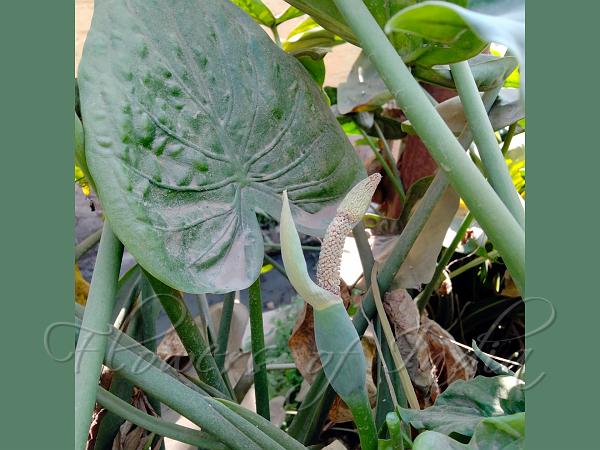|
| Chinese Taro |
|

|

|
|
|
|
Photo: |
Botanical name: Alocasia cucullata Family: Araceae (Arum family)
Synonyms: Arum cucullatum, Colocasia rugosa, Alocasia rugosa
Synonyms: Arum cucullatum, Colocasia rugosa, Alocasia rugosa
Chinese Taro is a clump forming herb, small to medium
sized, somewhat robust, up to 1 m, evergreen. Stems are erect,
hypogeal, basally much branched. Leaves arise many together; leaf-stalk
weakly D-shaped in cross section, 25-30 cm, sheath reaching to about
1/2 way, margins membranous; leaf blade broadly ovate-heart-shaped,
10-40 x 7-28 cm, base shallowly heart-shaped, tip pointed; primary
veins 4 on each side, radiating from leaf-stalk, arching, interprimary
veins not forming a collective vein. Inflorescences are rarely
produced, usually solitary, sometimes paired, among leaf bases,
subtended by membranous cataphylls; flower-cluster-stalk are 20-30 cm.
Spathe green, 9-15 cm; proximal spathe 4-8 × about 2.5 cm; limb
narrowly boat-shaped, 5-10 x 3-5 cm, spadix 8-14 cm. Fruit is rarely
produced, a nearly spherical berry, 6-8 mm in diameter, ripening red.
Chinese Taro is found by watersides, by fields, wild or cultivated,
below 2000 m, in China, Bangladesh, NE India, Laos, Myanmar, Nepal, Sri
Lanka, Thailand, Vietnam. It is an important good-luck plant in
Buddhist temples in Laos and Thailand. Flowering: May.
Medicinal uses: The plants are used externally
for detoxifying viper bites and are also used for treating abscesses,
rheumatism, and arthritis.
The plants are used externally
for detoxifying viper bites and are also used for treating abscesses,
rheumatism, and arthritis.
Medicinal uses:
 The plants are used externally
for detoxifying viper bites and are also used for treating abscesses,
rheumatism, and arthritis.
The plants are used externally
for detoxifying viper bites and are also used for treating abscesses,
rheumatism, and arthritis. | Identification credit: Huirem Bhabini | Photographed in Imphal, Manipur. |
• Is this flower misidentified? If yes,